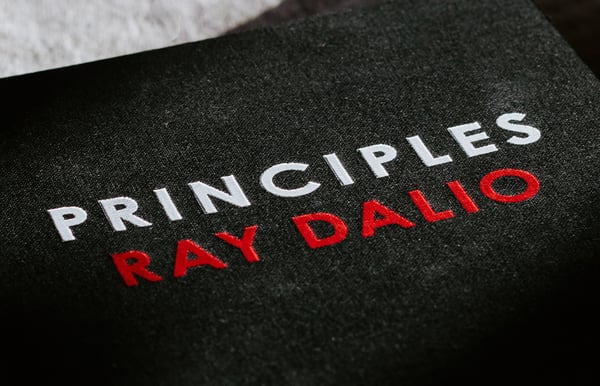Why should you care about what Ray Dalio thinks…
I hate losing more than I love winning. In fact, I refuse to lose for the same reasons twice.
If you are like me, you play-to-win.
The recipe for winning is really quite simple. Playing to win requires getting the right people in the right seats on the bus aligned around a common mission with radical transparency. My professional experience has been accelerated by my own successes and failures as well as the incredibly sage content of the likes of Peter Drucker, Jim Collins, Jack Welch, Marcus Aurelius, and particularly Ray Dalio.

Ray Dalio gets it. Tremendously.
In short. Ray Dalio has “been-there-done-that.” He has incredible experience coupled with humility. Dalio understands what it takes to be successful at a level few seem to truly grasp. He developed his principles to help get what he wanted out of life and help better align his team/organization. He has made a LOT of mistakes and he is not shy about sharing them.
I have been following Dalio for several years. I downloaded Ray Dalio’s Principles pdf long prior to when his book by the same title was published in 2017. Today (as I did several years ago), I often find myself nodding in agreement when reviewing his content. There is a reason the book was named “Principles” - they are foundational.
After more than 20 years of working with founder-led Fortune 500 companies and non-profits, I have realized that great organizations get the right people doing the right things right through the alignment of their people, systems, and culture.
In Principles, Dalio puts forth the idea of an organization as a “machine consisting of two major parts: culture and people. A great organization has both great people and a great culture. Great cultures bring problems and disagreements to the surface and solve them well, and they love imagining and building great things that haven’t been built before.”
Following are several of Ray Dalio’s principles that I have found particularly valuable. If you are familiar with his work, you will realize that I am barely scratching the surface in this piece. Invest your valuable time in reading his timeless book - Principles.
Tip: Check out Ray Dalio on LinkedIn. He is very active in sharing key Principles in frequent, bite-sized chunks.
While Dalio’s Principles are comprehensive, I believe the following five are pillar Principles:
- Life Principle 1.7: Pain + Reflection = Progress.
- Life Principle 4.1: Understand the power that comes from knowing how you and others are wired.
- Life Principle 4.5: Getting the right people in the right roles in support of your goal is the key to succeeding at whatever you choose to accomplish.
- Work Principle 2.1: Be loyal to the common mission and not to anyone who is not operating consistently with it.
- Work Principle 8: Hire Right, Because the Penalties for Hiring Wrong Are Huge.
Life Principle 1.7: Pain + Reflection = Progress
“There is no avoiding pain, especially if you're going after ambitious goals.” - Ray Dalio
A powerful mindset that facilitates the conscious acceleration of incremental improvements is what I call “fast feedback looping.” This is a mindset I believe Dalio advocates.
Echoing Dalio… pain is a reality that can be used to iteratively improve if approached correctly and quickly. The problem is most people do whatever they can to avoid it. Like Dalio, I advocate habituating “dealing with pain.” Step into the pain.

Fast feedback looping is the process of accelerating pain + reflection to progress.
Fast feedback looping facilitates repeat games being played with outcomes (positive/neutral/negative) being evaluated in as real-time as possible and scored so that the organization may learn from successes and failures alike. The outcome is a dramatically-increased speed of evolution.
Like Dalio, I recognize that psychologically or emotionally, very few people “enjoy” the process of reviewing what did or did not go well in a given circumstance. Few people are comfortable being in the hot seat. This habit can take time for people and teams to become comfortable with.
Choose your hard… Repeating the same costly mistakes over and over again is hard. Habitualizing the thoughtful review of successes and failures is also hard. Choose your hard…
If you expect to win more frequently, it is essential to hardcode the mindset of fast feedback looping - pain + reflection through the purposeful review of successes and failures alike into your organizational DNA - your culture code.
This can seem very much like jumping into cold water. The practice of stepping into the pain / fast feedback looping is mentally challenging for most everyone but once implemented, there are few regrets. To facilitate this pain + reflection = progress mindset in your team and organization, I recommend adopting the thought process of mentally getting every team member on the “same side of the table” where the successes/failures/problems are analyzed as objectively as possible. The key is to maximize emotional safety by making fast feedback looping a norm and ensuring every team member is experiencing the process as safely as possible. This can take many months (or longer) to fully accomplish.
It is also important to cultivate a mindset of purposeful experimentation that leads to incremental improvement. Design experiments and review through trial and error.
Change the perspective of making errors/mistakes as “bad” to the “tuition” paid to improve instead.
Keep in mind that the key to speeding up progress is to speed up your experiments and fast feedback loops. This is where innovation is fostered.
Life Principle 4.1: Understand the power that comes from knowing how you and others are wired
Life is energy. I am in my early 50s and focused on increasing good energy and decreasing the bad through balance, reducing bad friction, and heightening time in the flow state.
Increase the good. Decrease the bad.
Friction occurs when something unpleasant is experienced. Two relevant examples follow:
- Working in a role that is not aligned with one’s interests and passion.
- Attempting to communicate - connect - engage another person who is clearly wired quite differently than I am.
I believe “good friction” occurs as well. For example, if you have been fortunate enough to work with people doing work you love you naturally expend energy and become tired throughout the experience. Another example of “good friction” would be completing a HIIT workout that left you exhausted and feeling strong simultaneously.
“Flow” is the opposite of negative friction. I am inspired by the words of Mihaly Csikszentmihalyi, author of Flow: The Psychology of Optimal Experience (1990). He wrote:
“Flow is “a state in which people are so involved in an activity that nothing else seems to matter; the experience is so enjoyable that people will continue to do it even at great cost, for the sheer sake of doing it”
We have all experienced a day that seems to just fly by. Hopefully, that day is not limited to just weekends or holidays.
Back to the two examples shared previously.
- Hiring people who cannot do or enjoy the work is not only bad for productivity but also for the person hired in a role they are not wired for.
- Communicating with others the way you like to be communicated with may work for you or against you. Everyone is “wired” to appreciate a particular communication style.
There is good news. Every human being is uniquely-wired, and as complex as this truly is and sounds, there are ways one can greatly accelerate their understanding of themselves and others. One can identify how people are “wired” using powerful psychometric assessments to identify job match potential as well as preferred communication patterns.

I discovered the power of psychometric assessments almost 20 years ago. Since discovering the TriMetrix® HD, my life has literally not been the same. I have observed tremendous benefits to helping those I serve to improve their self and interpersonal awareness, to connect better with themselves and others, and to honor their own greatness and that of others.
“If you’re not failing, you’re not pushing your limits, and if you’re not pushing your limits, you’re not maximizing your potential.” - Dalio
Life Principle 4.5: Getting the right people in the right roles in support of your goal is the key to succeeding at whatever you choose to accomplish.
Dalio’s Principle 4.5 is teed up well by Principle 4.1 - Understand the power of knowing how yourself and others are wired.
Principle 4.5 comprises three very strong elements that must be aligned… the RIGHT people in the RIGHT ROLES in support of your GOAL. This alignment requires a commitment to:
- Hiring only those who are right for the role.
- Providing crystal clear clarity about the needs of each role.
- Shaping clarity regarding the goal and “GPS” that illustrates proximity to the goal.
- Having a development plan for each team member to maximize their growth trajectory.
Imagine how many people Dalio has been involved in hiring and experienced the opportunity to reflect on the outcomes of those decisions and then incrementally refine the decision process.
What gets measured gets improved.
This is an area I am particularly passionate about because I have observed the results firsthand. EVERY role can and should be quantified. So many leaders say they care about their organization, team, and each human being, but then they make ad hoc hiring decisions and then fail to lay out the expected path to success.

If success is your objective, EVERY role must be laid out in terms of the Key Accountabilities required to perform well and the ideal personality style, job duties, experience, background, and education. This process is called “benchmarking the job.” If one truly cares about the success of the organization, team, and each team member, EVERY role must have a job benchmark to ensure the best talent possible is hired for the role AND that the needs of the role are extremely clear to those hired.
While human beings are extremely complex, powerful psychometric assessments like the TriMetrix® HD may be deployed to objectively quantify key personality aspects to understand if the appropriate match is there. The TriMetrix® HD helps shed light on a person’s Behavioral Style (how) and Driving Forces (why).
As I mentioned in Principle 4.1, psychometric assessments are the key to maximizing job match as well as maximization of self and interpersonal awareness. Psychometric assessments are also instrumental for employee selection - ensuring the right people are selected and hired in the first place. Contact me to discuss this further.
Click here to view a no-obligation, free sample assessment
A word of caution. Human Resources must be strategic and have a seat at the executive table for the organization to maximize its potential. HR is not often strategic - particularly in smaller organizations. Make sure HR is strategically-minded and engaged.
Whether we like to believe it or not, HR is often directly (through hiring) or at least indirectly engaged (hired outside their purview) in ensuring the right people are in the right roles. I have observed organizations deploy HR strategically (strategic talent management) to ensure this occurred. I have also observed HR essentially being cut out. At the other end of the spectrum, I have observed HR using a hiring approach that, while perhaps somewhat standardized, feedback loops did not exist because this would illuminate weakness and potentially expose HR to scrutiny (God forbid). The full, strategic potential of HR cannot be unleashed unless they are held accountable to a relevant and continuously improving standard.
Work Principle 2.1: Be loyal to the common mission and not to anyone who is not operating consistently with it.
“We are a team, not a family. We’re like a pro sports team, not a kid’s recreational team. Netflix leaders hire, develop and cut smartly, so we have stars in every position.” - Reed Hastings in Harvard Business Review.
Is your team/organizational culture more like a family or a professional sports team?
One of the biggest mistakes I have observed executive leaders make is putting people before the mission. With the rise of the “Great Resignation,” this seems to become an even more significant issue as leaders attempt to make their workplace more inviting to retain and attract talent.
I once worked with a manufacturing company to assist them in positioning themselves to be purchased by a private equity firm. I helped my Client rev up their profits and enhance their culture. Over the course of 24 months, I helped them clarify their “Due North” in terms of their mission, vision, and values and shape their culture code. I also helped my Client design and monetize their Customer Experience. This Client was particularly motivated and quickly adopted the recommended improvements. The results were profound. My Client monetized their Customer Experience like no other and got their culture sorted out, shaped, and aligned.
It was truly beautiful.
Then, as hoped, a private equity firm bought my Client’s company to infuse their DNA / Culture Code / Mindset into a floundering portfolio company. My Client’s company was smaller and scrappier, while the floundering portfolio company was much larger and a laggard.
The bigger company—the floundering portfolio company— ultimately “won” the culture war that ensued. They were floundering for a reason. It seemed that the floundering portfolio company was actually afraid of losing their employee team members. Accountability was practically non-existent. There were instances where employees did not show up for work for days at a time with no repercussions. One employee ran a business from their office; everyone knew it, but nothing was done. This floundering portfolio company did not engage in conflict, nor did they want to understand the value of doing so. High performers came and went while low performers remained for their careers.

Long story short, after several months of struggle, my Client realized they had made a grave mistake selling their business and merging it with the floundering portfolio company. Needless to say, the DNA transfer and culture shift simply did not stick. Most of my Client’s key management team members and high performers left within the following 12-18 months.
The floundering portfolio company was unwilling to make the hard transition to ensuring that everyone was rowing in the same direction. They were more loyal to employee team members than to the mission and Customer.
This company is still floundering to this day.
If your team is not individually and collectively aligned towards accomplishing a mission, then each team member will inevitably do whatever they wish to serve their best interests. The outcome is predictable. Unless you are willing to make the hard decisions to set the tone - to create accountability, you will flounder.
When loyalty to one another trumps loyalty to the common mission, the only outcome is mayhem and missed potential. The more competitive the industry, the worse the mayhem and missed potential. Loyalty to the mission and the Customer who pays the bills must reign supreme. Loyalty to the mission and Customer must be hard-coded into the DNA and organizational culture.
Work Principle 8: Hire Right, Because the Penalties for Hiring Wrong Are Huge
By now, you are probably observing a pattern. Get the right people in the right roles to support your goal, and know and understand the power of knowing how you and others are wired.
Step one - Identify the cost of the problem. When you hire the wrong person, the costs are enormous and often masked as they hit the bottom line. It is difficult to make change happen when costs are masked.
Therefore, it is ESSENTIAL that you quantify the costs of hiring the wrong people so that these costs become glaring and loud and draw the appropriate attention and resources..
If you are unaware of the penalties for hiring the wrong people, you will never have the economic incentive to address this problem as fully and intentionally as you must. The stakes are incredible.
Imagine if “poor hiring outcomes” or “missed sales due to bad sales hires” were an actual line item in your balance sheet. If that were the case, I promise many leaders would do much more to avoid the costly error and expense of putting the wrong people in the wrong seats. We have all observed it, yet it seems to be ego (i.e., “I know good talent when I see it”) or pure laziness.

Step two - Quantify your talent. What gets measured gets improved. And I am all about measuring absolutely everything (objectify the subjective) possible. And leaders can absolutely quantify talent in terms of experience, background, education, and personality.
Speaking of personality… Reviewing my article content, you will notice a common thread or theme that runs through these three of the four prior-shared Principles. That “common thread” is psychometric assessments. While people are profoundly more complicated than what a psychometric assessment can measure, the power of an invaluable tool that can objectively identify Behavioral Style, motivators, acumen, and competencies is profound. The key is to decide to jump in to understand the power of a solid psychometric assessment like the TriMetrix(R) HD and learn how to benchmark a job properly.
It is up to you.
Are you tracking with my selection of the five most essential Principles from Ray Dalio, or do you believe others are more significant? Drop me a line, and let’s discuss. I am always curious about your experiences and perspective.
As mentioned previously, I hate losing more than I love winning. The experiences I have had where I lost involve being accountable for improving my perspective and approach because I have one person to blame - the person looking back at me in the mirror.
I recommend you begin with a similar mindset.




